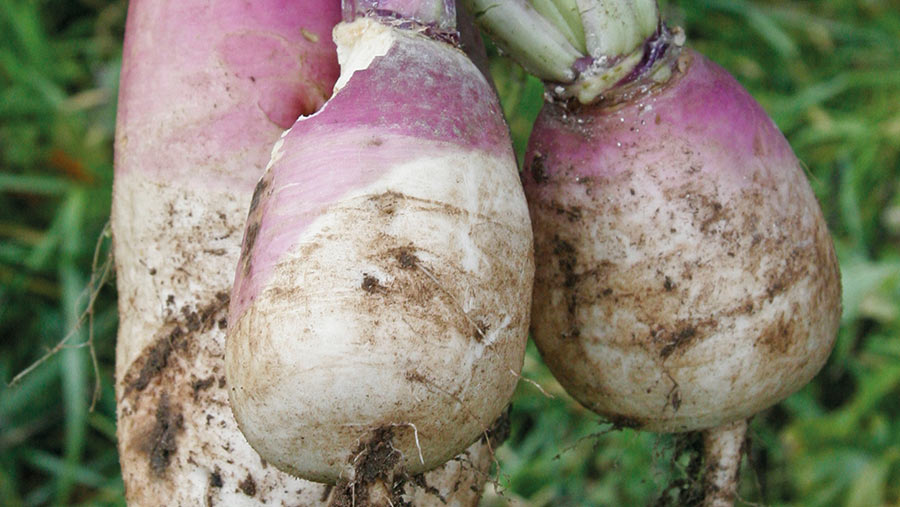How to get the best from stubble turnips for forage
 © Tim Scrivener
© Tim Scrivener With just two months from sowing to feeding, stubble turnips potentially deliver one of the quickest turnarounds of all forage crops suitable for sheep.
While they don’t offer the highest yield compared to some alternatives, stubble turnips have endured because they are fast-growing, help to build soil fertility and suppress weeds.
Independent grassland and forage specialist Charlie Morgan says they are best suited as a break crop on a lowland farm and block grazed.
“If there is a crop of winter barley coming off at the end of July, for instance, stubble turnips would work well as a break crop ahead of another cereal crop or grass reseed in the spring,’’ he says.
“It also provides a good stop-gap for feed, when grass production is slowing off in dry areas.’’
See also: How lucerne could help bridge summer forage gap
Growing stubble turnips
From sowing to feeding takes 75 days, so consider when the crop is needed for feeding and work back to calculate the sowing date.
This will be in April or May for a summer feed, but it is more often sown in late July or early August for an autumn/winter crop.
It will perform best in free-draining light loam soils with a pH of 6.5. Seed rate varies from 2.5-6kg/ha, depending on the method of sowing.
Avoid growing on steeper slopes or near watercourses to prevent the risk of run-off. Wet fields are not suitable, as ground conditions must be reasonably dry for grazing.
When planning the layout of the crop, consider where loafing areas and a run-back need to be, and where supplementary fibre can be fed.
In higher rainfall regions select fields with multiple access points so new grazing areas can be accessed and alternative loafing areas can be used if needed.
Like most brassicas, stubble turnips are at risk of club root infection so ensure good crop husbandry practices are used, such as avoiding continuous cropping.
Pest control is also becoming an issue following the withdrawal of some treatments used for protecting stubble turnip seeds.
Notably, this has led to more and faster flea beetle infestations.
“Flea beetles can get into a crop very quickly,’’ says Mr Morgan. “Visually they create pinprick holes on the leaf, but they can cause significant damage and crop failure if not treated quickly.
“It isn’t costly to rescue the crop from an attack using a spray programme, but you need to get onto it quickly.’’
Selecting the right variety
Vollenda, Samson and Delilah have stood the test of time as the top-performing varieties.
It’s best to incorporate a blend of varieties in the seed mix as an insurance policy against one underperforming or failing; alternatively, add another crop variety such as rape to produce a higher yield.
Consider the leaf to stem ratio – for instance, the varieties Winfred and Avalon are predominately green top, so they are probably more suited to summer or autumn use.
“Lambs will finish quicker on varieties with more leaf because that’s where the protein is, but the crop is less hardy and won’t last as long,’’ says Mr Morgan.
“If you want to graze later in the season, you will need a hardy variety which will have more bulb.’’
Stubble turnips typically yield 4-6t DM/ha, 10% dry matter, 11% metabolisable energy and crude protein of 18%.
Transitioning lambs onto stubble turnips
Ideally, stubble turnips should only account for 70-80% of a lamb’s diet; the remainder should come from a grass run-back or from baled silage as a fibre source.
Lambs will take to the crop more easily and perform better if they are gradually introduced to it in the first week.
“Initially, they will eat the green tops but not the bulbs, so training is needed in that first week with sufficient grazing pressure to encourage them to eat the bulbs,’’ says Mr Morgan.
Grazing to achieve good utilisation
Electric fences are a must, or the lambs will walk over the crop, eating the leaf and leaving the stem and bulbs.
If the grazing is well-managed, budget for a utilisation rate of 80%.
Supplementary feed requirements
An ad-lib supply of fibrous forage such as hay, silage or straw is recommended, as well as a clean run-back area.
Health issues
Trace element deficiency needs to be considered because stubble turnips are low in iodine, phosphorus and magnesium.
To ensure lambs are covered, administer boluses, or provide access to minerals.
Case study: Robert Law, Thrift Farm, Royston, Hertfordshire

Robert Law © Tim Scrivener
Farm facts
- 1,800ha (4,449 acres), a mix of owned, rented and contract-farmed, mostly down to arable cropping
- Early-lambing sheep flock and lambs bought in to finish
- Finished lambs sold to independent butcher and Thrapston market
- 50 Salers suckler cows
- 600mm annual rainfall
Robert Law grows up to 320ha (791 acres) of stubble turnips as a catch crop for store lambs. They are a good fit for his light soils.
Half the area follows winter barley and the other 160ha (395 acres) is grown after rye and wheat.
The preceding barley crop is harvested in mid-July and the stubble turnip seed is then drilled with a 9m Horsch Pronto drill at a rate of 2.5kg/ha.
An early post-emergent spray application supresses barley volunteers and treatment is used for flea beetle control before 80kg/ha of nitrogen is applied (see table).
Stubble turnip crops following rye and wheat are drilled in the first half of August. Both areas are a 50:50 mix of the purple-skinned Samson variety, and Delilah, a white-skinned turnip.
“A mixture always seems to work better,’’ says Mr Law.
The turnips that follow the barley are always more successful because of the early establishment, he adds.
“We have an absolute cut-off date of 20 August – any later and it just doesn’t work. At that time of the year a week or two makes a big difference.’’
The earlier-sown crop is grazed from mid-November with home-reared and bought-in store lambs; these are finished on turnips only.
The 2020-sown crop was grazed until 3 April, but crop quality began to deteriorate from mid-March.
Last season the turnips were grazed by 1,500 hoggets and, as the business has an early lambing flock, ewes with January-born lambs were turned onto them from mid-January until late March.
Mr Law believes stubble turnips are an excellent feed for finishing lambs.
“A good crop will give you 1,000 grazing days/ha,’’ he says. “If lambs gain 300g a day of liveweight gain, that’s 300kg a day over 1,000 lambs, so £400/ha plus is achievable.
“This year the crop was so good that we had 400 in-lamb shearling ewes on there, too.”
But he cautions: “Stubble turnips are not only a catch crop but a catchy crop. Last year ours was exceptional, but they can be a disaster if you don’t get rain at a critical time, or weeds and volunteers take over. They can’t always be relied upon.”
Variable costs for stubble turnips at Thrift Farm |
|
|
Variable costs |
£/ha |
|
Seed |
£2.87 |
|
Sprays |
£17.97 |
|
Fertiliser |
£55.23 |
